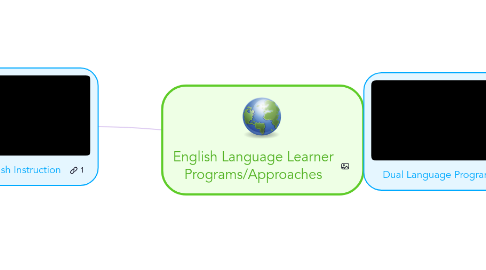
1. Sheltered English Instruction
1.1. Who?
1.1.1. ELLstudents at any grade level usually beyond beginner proficiency
1.1.2. Variety of linguistic and cultural backgrounds
1.2. Setting
1.2.1. All English setting
1.3. Goals
1.3.1. Students develop a proficiency in English while learning academic content
1.4. Content
1.4.1. Instruction is in English
1.4.1.1. Adapted to level of English proficiency
1.4.2. Variety of strategies and tools used to incorporate language development during content instruction
1.4.3. Ideally content area teachers are trained in Sheltered English instruction techniques
1.4.4. Elements of Sheltered English Instruction
1.4.4.1. Preparation
1.4.4.2. Building Background
1.4.4.3. Comprehensible Input
1.4.4.4. Strategies
1.4.4.5. Interaction
1.4.4.6. Practice/Application
1.4.4.7. Lesson Delivery
1.4.4.8. Review and assessment
1.5. Teaching strategies
1.5.1. Clear, direct simple language initially, gradually becoming more complex
1.5.2. Use of Visual aids and gestures
1.5.3. Collaborative group work
1.5.4. Scaffolding techniques
1.5.5. Use students previous knowledge
1.5.6. Adjusting tone, rate of speech
2. Dual Language Program
2.1. Who?
2.1.1. ELL and English speakers wanting to learn a second language
2.1.2. Typically begins in elementary schoolbut Middlae and High schools exist
2.2. Goals
2.2.1. Proficiency in 2 languages
2.2.2. Bilingual, Biliterate, Bicultural and/or postive cross culture attitudes
2.2.3. At or higher grade level academic achievement
2.3. Setting
2.3.1. Dual Language setting
2.4. Models
2.4.1. 90:10
2.4.2. 50:50
2.5. Content
2.5.1. Instruction occurs in both languages for all subjects, usually alternating
2.5.2. Teachers often are bilingual
2.5.3. In US often dual language programs are Spanish and English; however other programs with a different second language exist ie Chinese, French, Creole etc
2.6. Teaching strategies:
2.6.1. Create a welcoming learning environment reflecting children's background - posters, pictures, toys, books representing their cultures in an authentic way
2.6.2. Ask families to share information about their child's interests and infuse this in the classroom
2.6.3. Provide opporutnities for families to share stories and information in their home language
